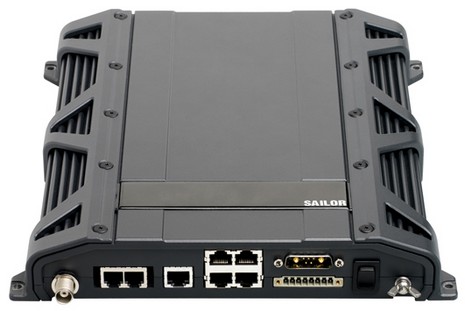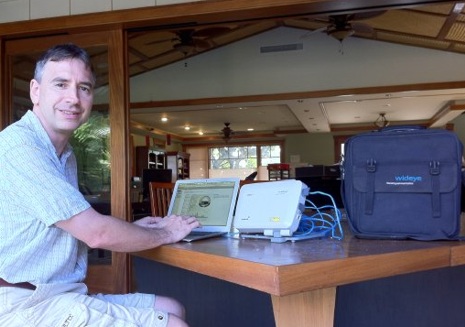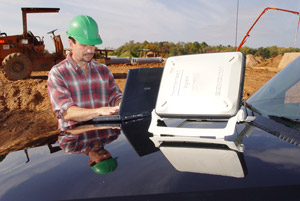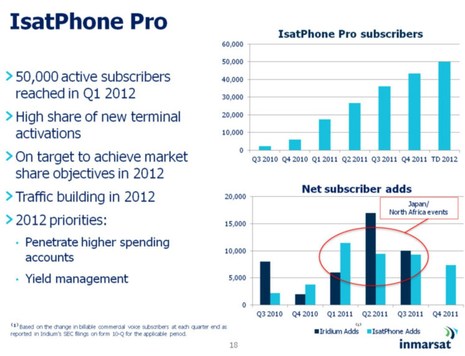Fleet Broadband, today’s the day

It’s official. Today Inmarsat flipped the switch on the marine version of BGAN, dubbed Fleet Broadband. It’s been a while coming, as noted here last March, but the good news is that the smallest dome turns out to be less than a foot tall. Thus the new KVH TracPhone FB250 is almost the same size as the company’s existing TP 252 dome (Inmarsat Mini-M), as shown above in a photo I took at the NMEA Conference back in mid-October when KVH officially introduced the products. The big difference is that the Mini-M offers “dial-up” style data service “up to 9.6 Kbps” while the FB250 offers a “standard IP” always-on connection “up to 284 Kbps”. The bad news is that this wee dome still costs about $13,000 and pay-as-you-go data is about $13.50 per MB. Now that data cost is less than the earlier Fleet series (which charged in megabits not megabytes), but it’s still wicked costly if you want to surf the Web the way most of us do at home or work.
There’s a lot more to Fleet Broadband, like the bigger/faster FB500, and all the tricks the BDU (below decks unit, shown below) has up its IP sleeve, like simultaneous high quality voice calls. KVH has the info pretty well laid out, though note that most of its FB gear is in fact built by Thrane & Thrane. Harder to understand is the complex business structure of Inmarsat and where it’s headed versus the highly competitive and evolving VSat systems (like KVH’s own TP V7). What’s a big budget yacht to do? And will us smaller budget boaters ever get offshore broadband? I learned bits and pieces about the first question at all three shows I went to this Fall, and you’ll be hearing more as I sort it all out. As for the latter question, anyone have a guess?














Ben,
Does the biz model for offshore broadband make sense to have such high end products aimed at the very top end?
Is this simply a matter of limited bandwidth and so it HAS to be so expensive or could a lower cost service be provided to a broader market?
Targeting the top end is a good biz model because the margins are greater and there are fewer clients to service and money is usually no object up there in the stratosphere. This doesn’t portend well for the lowly yachatsmen does it?
Is there are lower-end market for this? Not yet. Sure all Panbo readers want one but until iPod-totin’ students want it in droves it won’t go “consumer” and get cheaper.
In the future probably all cell/data service will be via satellite, will be global, and will be dirt cheap.
Ouch … so much money to a share a standard dedicated 284K transiever port on a satalite, that is presumably shared with 100’s or 1000’s of users. Either the sales & marketing costs to aquire new customers justify this (like the cost of attending these shows), or I am in the wrong business.
It will not be interesting until data price will fall to $0.5/MB. I can afford a $13K unit even it costs roughly a half of my yacht. But I can’t afford $13K/month in traffic expenses (I’m web programmer and I use about 1GB of data per month).
to DefJet
re it HAS to be so expensive
You are right, it has to be that expensive. There were LOTS of rumors in between of sailors_programmers and sailors_server_admins before BGAN launch, that traffic will cost about $0.45-0.55 per MB. But Santa doesn’t exist.
Five years ago I could only get a 128Kb ISDN connection at my home, no broadband at all, so this is big progress in one sense.
Let’s do some math, or very rough arithmetic. Assuming 256Kbs, that’s 32KB/sec which means it takes roughly 30 seconds to download a megabyte and spend $13.50. If you could drive it at more or less full speed, you could burn about $27/min. Half an hour a day of surfing the web, assuming you were downloading 25% of the time (reading and typing take the other 75%) would cost you about $200 / day. Take a few days off each month so you only use the web on 25 days and you can stimulate the telecommunications economy by about $5,000 / month. Chump change for any megayacht owner, but well beyond the budget of most cruisers.
And who cares about $13,000 of equipment cost when you’re going to spend $60,000 / year on the service?
But you’ve downloaded roughly 370MB. If you had the patience, at Iridium’s 2.4kbs, it would take you about 340 hours and you’d spend in the neighborhood of $20,000 to download the same amount of data. So the BGAN is a much better use of both your time and money. None the less, I think it’s safe to say that not too many cruisers will be dumping their Iridium phones for a BGAN unit.
The question I’m left asking is why is there nothing in between? It seems like there ought to be some middle ground between the $1,500 cost of an Iridium phone at 2.4kbs and the 10x cost of BGAN equipment to get 100x the performance. Maybe 2x the Iridium equpiment cost for 10x the performance and 50% of the cost / byte? Does that product / service exist?